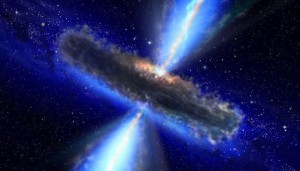New data shed light on last month’s exciting discovery of a black hole triplet — but they suggest instead that the threesome is really just a twosome.

NASA
Scientists are always skeptical of new claims. So it shouldn’t come as a surprise when new discoveries are called into question. They can be a topic of debate and back-and-forth banter for years.
A prime example is the recent discovery of a black hole trio. Although the media (including S&T) gleamed with headlines about this exotic system and raised hopes for what it might herald, newly announced observations suggest that the black hole system might be less than it seems.
A Triple Supermassive Black Hole?
Astronomers first identified the system SDSS J150243.09+111557.3 as a quasar — a supermassive black hole rapidly accreting material at the center of a distant galaxy — three years ago. But its double-peaked spectrum suggested there were two supermassive black holes hiding in the galaxy’s core, lying roughly 24,000 light-years from each other.
Last month, Roger Deane (University of Cape Town, South Africa) and colleagues used observations from the world-spanning European VLBI network to resolve one of the two supermassive black holes into two separate radio signals lying 450 light-years apart.
The double signal indicated that again the source was not one, but two supermassive black holes, meaning the system contained three supermassive black holes in total.
Everyone was thrilled. It was, after all, the tightest trio of black holes known to date. Before then, only four triple black hole systems were known, with the closest pair being 7.8 thousand light-years apart — nearly 2,000 times the distance from Earth to the nearest star, Proxima Centauri. But the new pair had a separation nearly one-twentieth as wide.
Deane and colleagues looked through six similar galaxies before finding this trio. The fact that they found one so quickly suggested that binaries were more common than previously thought, holding implications for galaxy evolution and cosmology.
But the result had to be true, withstanding further observations.
The Scientific Debate Begins . . .
Deane’s results rippled through the astronomical community. And when Joan Wrobel (National Radio Astronomy Observatory) and colleagues saw that this source might be a compact triplet, they decided to take a second look.
Luckily the team had been sitting on data from the VLBA (a similar array to the European VLBI network, with 10 identical antennas across the United States) of the distant system for a few years. “We already had the data, but we got busy with other research problems,” says coauthor Hai Fu (University of Iowa). Deane’s results prompted them to take a closer look at their data and see if they could spot anything interesting.
The team was surprised to find that their data went much deeper, revealing an odd structure that seemed to be linking the two radio sources together. “So we thought, ‘Wow, maybe we should re-evaluate the possibility of this binary black hole interpretation,’” explains Fu.
Wrobel’s team now interprets the double signature as a single black hole shooting off jets. When the jets hit the interstellar medium, they form hot spots. So the two radio sources are not two separate black holes, but two hot spots formed from the jets of a single black hole.
“This result is interesting and reveals some substructure that was not possible to see in our slightly less sensitive and lower resolution data,” says Deane. But although he acknowledges that the VLBA observations cast doubt on the triple black hole, he cautions that (as the authors themselves say) further observations are required to explore this alternative interpretation further.
Wrobel’s team favors their argument — while secretly hoping that they’re wrong. If the tight binary exists, it would allow astronomers to explore uncharted territory, such as realms warped by strong gravity. But the results remain inconclusive. Wrobel's team has already put in a proposal for another round of observations.
“This is an ongoing scientific debate,” says Fu. “I hope the public can enjoy it.”
References:
R. P. Deane et al. “A Close-pair Binary in a Distant Triple Supermassive Black-hole System” Nature, June 25, 2014
J. M. Wrobel et al. “Evidence from the Very Long Baseline Array that J1502SE/SW are Double Hotspots, not a Supermassive Binary Black Hole” The Astrophysical Journal Letters , Accepted
Take your own look into the distant universe this season, guided by our Summer Deep Sky eBook.
 0
0









Comments
You must be logged in to post a comment.